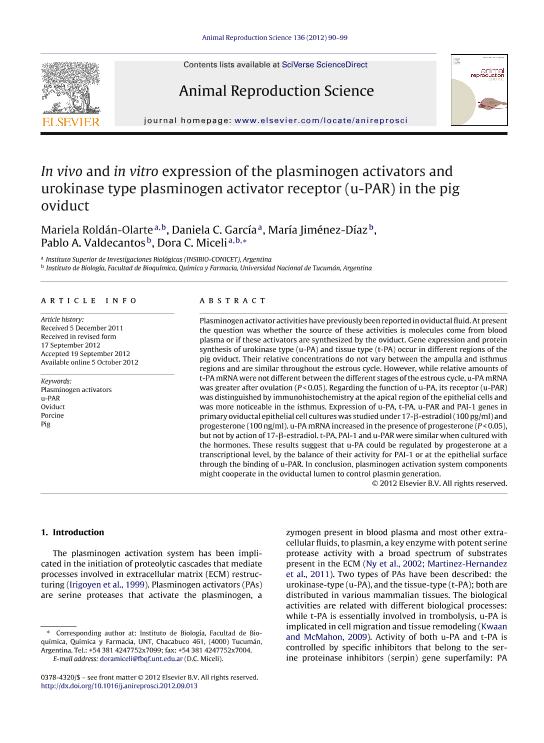Mostrar el registro sencillo del ítem
dc.contributor.author
Roldán-Olarte, Mariela
dc.contributor.author
Garcia, Daniela Celeste

dc.contributor.author
Jiménez Díaz, María Atilana

dc.contributor.author
Valdecantos, Pablo Alberto

dc.contributor.author
Miceli, Dora Cristina

dc.date.available
2021-03-08T11:20:54Z
dc.date.issued
2012-12
dc.identifier.citation
Roldán-Olarte, Mariela; Garcia, Daniela Celeste; Jiménez Díaz, María Atilana; Valdecantos, Pablo Alberto; Miceli, Dora Cristina; In vivo and in vitro expression of the plasminogen activators and urokinase type plasminogen activator receptor (u-PAR) in the pig oviduct; Elsevier Science; Animal Reproduction Science; 136; 1-2; 12-2012; 90-99
dc.identifier.issn
0378-4320
dc.identifier.uri
http://hdl.handle.net/11336/127692
dc.description.abstract
Plasminogen activator activities have previously been reported in oviductal fluid. At present the question was whether the source of these activities is molecules come from blood plasma or if these activators are synthesized by the oviduct. Gene expression and protein synthesis of urokinase type (u-PA) and tissue type (t-PA) occur in different regions of the pig oviduct. Their relative concentrations do not vary between the ampulla and isthmus regions and are similar throughout the estrous cycle. However, while relative amounts of t-PA mRNA were not different between the different stages of the estrous cycle, u-PA mRNA was greater after ovulation (P< 0.05). Regarding the function of u-PA, its receptor (u-PAR) was distinguished by immunohistochemistry at the apical region of the epithelial cells and was more noticeable in the isthmus. Expression of u-PA, t-PA, u-PAR and PAI-1 genes in primary oviductal epithelial cell cultures was studied under 17-β-estradiol (100. pg/ml) and progesterone (100. ng/ml). u-PA mRNA increased in the presence of progesterone (P< 0.05), but not by action of 17-β-estradiol. t-PA, PAI-1 and u-PAR were similar when cultured with the hormones. These results suggest that u-PA could be regulated by progesterone at a transcriptional level, by the balance of their activity for PAI-1 or at the epithelial surface through the binding of u-PAR. In conclusion, plasminogen activation system components might cooperate in the oviductal lumen to control plasmin generation.
dc.format
application/pdf
dc.language.iso
eng
dc.publisher
Elsevier Science

dc.rights
info:eu-repo/semantics/openAccess
dc.rights.uri
https://creativecommons.org/licenses/by-nc-sa/2.5/ar/
dc.subject
OVIDUCT
dc.subject
PIG
dc.subject
PLASMINOGEN ACTIVATORS
dc.subject
PORCINE
dc.subject
U-PAR
dc.subject.classification
Biología Reproductiva

dc.subject.classification
Ciencias Biológicas

dc.subject.classification
CIENCIAS NATURALES Y EXACTAS

dc.title
In vivo and in vitro expression of the plasminogen activators and urokinase type plasminogen activator receptor (u-PAR) in the pig oviduct
dc.type
info:eu-repo/semantics/article
dc.type
info:ar-repo/semantics/artículo
dc.type
info:eu-repo/semantics/publishedVersion
dc.date.updated
2021-02-17T20:55:37Z
dc.journal.volume
136
dc.journal.number
1-2
dc.journal.pagination
90-99
dc.journal.pais
Países Bajos

dc.journal.ciudad
Amsterdam
dc.description.fil
Fil: Roldán-Olarte, Mariela. Consejo Nacional de Investigaciones Científicas y Técnicas. Centro Científico Tecnológico Conicet - Tucumán. Instituto Superior de Investigaciones Biológicas. Universidad Nacional de Tucumán. Instituto Superior de Investigaciones Biológicas; Argentina. Universidad Nacional de Tucumán. Facultad de Bioquímica, Química y Farmacia. Instituto de Biología; Argentina
dc.description.fil
Fil: Garcia, Daniela Celeste. Consejo Nacional de Investigaciones Científicas y Técnicas. Centro Científico Tecnológico Conicet - Tucumán. Instituto Superior de Investigaciones Biológicas. Universidad Nacional de Tucumán. Instituto Superior de Investigaciones Biológicas; Argentina
dc.description.fil
Fil: Jiménez Díaz, María Atilana. Universidad Nacional de Tucumán. Facultad de Bioquímica, Química y Farmacia. Instituto de Biología; Argentina
dc.description.fil
Fil: Valdecantos, Pablo Alberto. Universidad Nacional de Tucumán. Facultad de Bioquímica, Química y Farmacia. Instituto de Biología; Argentina
dc.description.fil
Fil: Miceli, Dora Cristina. Consejo Nacional de Investigaciones Científicas y Técnicas. Centro Científico Tecnológico Conicet - Tucumán. Instituto Superior de Investigaciones Biológicas. Universidad Nacional de Tucumán. Instituto Superior de Investigaciones Biológicas; Argentina. Universidad Nacional de Tucumán. Facultad de Bioquímica, Química y Farmacia. Instituto de Biología; Argentina
dc.journal.title
Animal Reproduction Science

dc.relation.alternativeid
info:eu-repo/semantics/altIdentifier/url/http://www.sciencedirect.com/science/article/pii/S037843201200303X
dc.relation.alternativeid
info:eu-repo/semantics/altIdentifier/doi/https://doi.org/10.1016/j.anireprosci.2012.09.013
Archivos asociados
